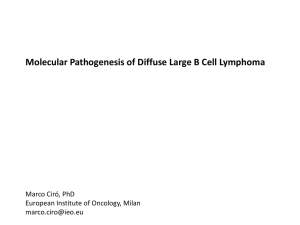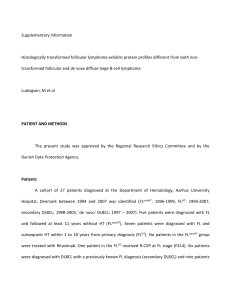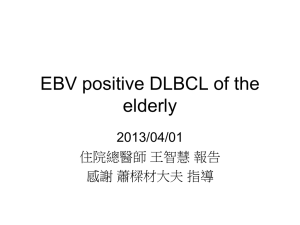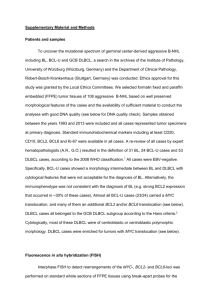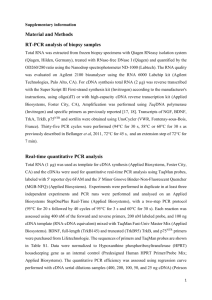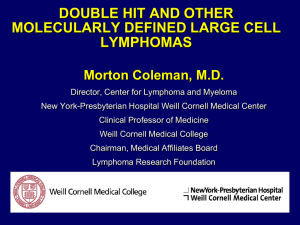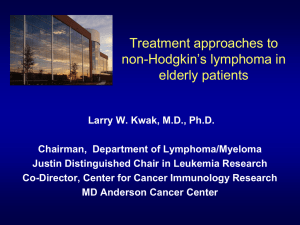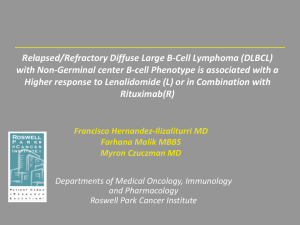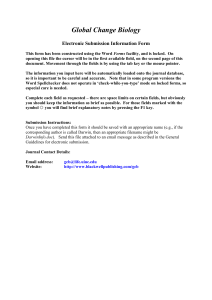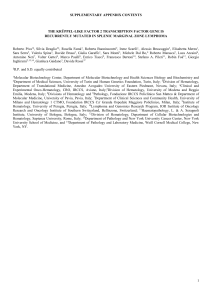Supplementary Information (docx 29K)
advertisement
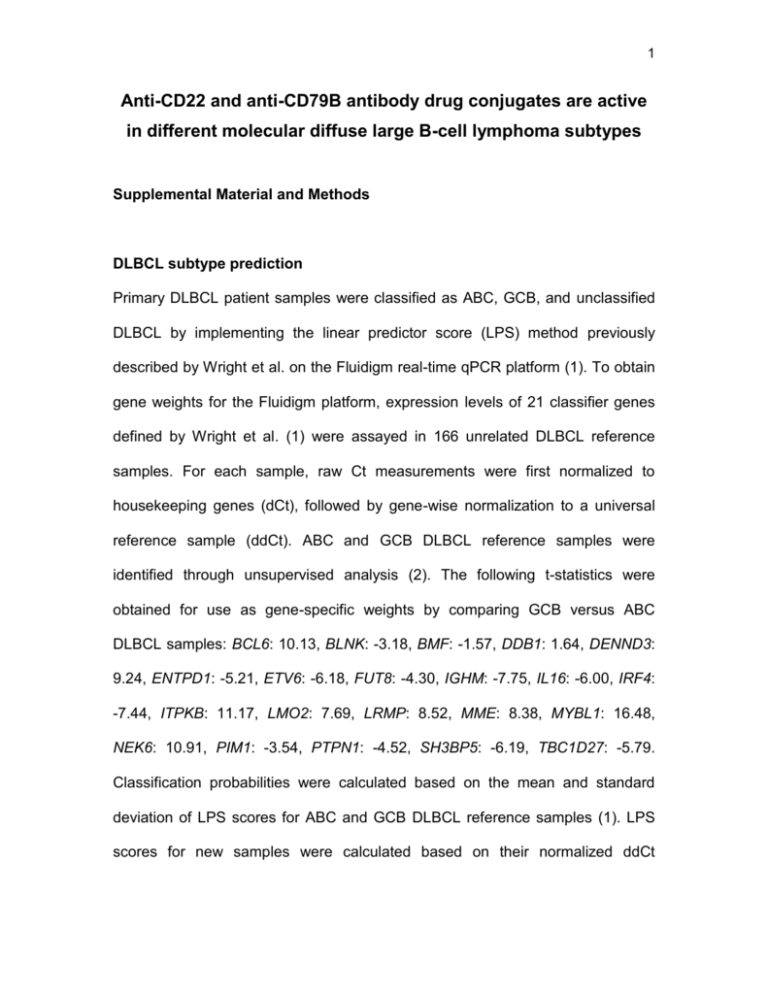
1 Anti-CD22 and anti-CD79B antibody drug conjugates are active in different molecular diffuse large B-cell lymphoma subtypes Supplemental Material and Methods DLBCL subtype prediction Primary DLBCL patient samples were classified as ABC, GCB, and unclassified DLBCL by implementing the linear predictor score (LPS) method previously described by Wright et al. on the Fluidigm real-time qPCR platform (1). To obtain gene weights for the Fluidigm platform, expression levels of 21 classifier genes defined by Wright et al. (1) were assayed in 166 unrelated DLBCL reference samples. For each sample, raw Ct measurements were first normalized to housekeeping genes (dCt), followed by gene-wise normalization to a universal reference sample (ddCt). ABC and GCB DLBCL reference samples were identified through unsupervised analysis (2). The following t-statistics were obtained for use as gene-specific weights by comparing GCB versus ABC DLBCL samples: BCL6: 10.13, BLNK: -3.18, BMF: -1.57, DDB1: 1.64, DENND3: 9.24, ENTPD1: -5.21, ETV6: -6.18, FUT8: -4.30, IGHM: -7.75, IL16: -6.00, IRF4: -7.44, ITPKB: 11.17, LMO2: 7.69, LRMP: 8.52, MME: 8.38, MYBL1: 16.48, NEK6: 10.91, PIM1: -3.54, PTPN1: -4.52, SH3BP5: -6.19, TBC1D27: -5.79. Classification probabilities were calculated based on the mean and standard deviation of LPS scores for ABC and GCB DLBCL reference samples (1). LPS scores for new samples were calculated based on their normalized ddCt 2 expression measurements and subtypes were assigned to those samples exceeding a 90% classification probability. Mutation analysis of CD79B in primary DLBCL patient samples Genomic DNA (200 ng) was isolated from archival patient material using the AllPrep DNA/RNA FFPE Kit (Qiagen, Venlo, Netherlands). CD79B was preamplified using sequences flanking the Y196 mutational hotspot (3). Taqman mutation assays were designed with forward primers specific to either the previously identified mutations or to the wild-type sequence (3). The same reverse primers and probes were used for all samples (Supplemental Table 1). Determination of IC50 concentrations and correlation analyses The IC50 concentrations were calculated by fitting cell viability over logarithmic 1−𝑜 titrated concentrations with a sigmoidal model (𝑣 = 1+𝑒 𝑠⋅(𝑐−𝑐𝑚) + 𝑜 with 𝑣 = viability, 𝑐 = logarithmic ADC concentration, 𝑐𝑚 = center with the steepest viability slope, 𝑠 = steepness and 𝑜 = offset viability) using nonlinear least squares optimization. For each cell line, the IC50 value was retrieved from the resulting fit function at a viability of 50%. We used Pearson correlation coefficients and linear regression to quantify and fit the association between logarithmic IC 50s of ADCs and target cell surface expression. 3 Determination of CD22 and CD79B surface expression by flow cytometry Determination of CD22 and CD79B expression in DLBCL cell lines was performed prior to ADC treatment. DLBCL cell lines were stained with either CD22-APC (eBioscience, San Diego, CA, USA; clone S-HCL-1) or CD79B-PE (eBioscience; clone CB3-1) or the corresponding isotype control antibodies. Cell surface expression was evaluated by flow cytometry of stained cells. Viability assay DLBCL cell lines were incubated with different concentrations of the unconjugated antibodies (anti-CD22 mAB and anti-CD79B mAB) and the corresponding ADCs (anti-CD22-MMAE and anti-CD79B-MMAE). Cell viability was measured after 72 hours of incubation using the Cell Titer Glo Assay (Promega, Madison, WI, USA) as previously described (4). Sub-G1 and cell cycle analysis To analyze changes in the sub-G1 fraction and the cell cycle, cells were washed in PBS, fixed with ice-cold 70% ethanol and kept for at least 20 minutes at -20°C. Cells were stained as previously described (4). Stained nuclei were analyzed by flow cytometry and quantified by FlowJo software. 4 Supplemental Figures Supplemental Figure 1: Classification of primary DLBCL patient samples into molecular subtypes. 52 primary DLBCL samples were classified as ABC, GCB or unclassifiable DLBCL analogous to Wright et al (1). 22 DLBCL samples were identified as ABC DLBCL, 26 samples as GCB DLBCL, and 4 samples as unclassifiable DLBCL. Supplemental Figure 2: Expression of CD22 and CD79B in DLBCL cell lines. A. DLBCL cell lines express significantly higher CD22 levels compared to the negative control cell lines derived from MM (p=2.2x10 -7) and ALCL (p=2.2x10-7). Depicted are the mean fluorescence intensity (MFI) expression levels of CD22 across the entities. Error bars depict the standard error of the mean. B. DLBCL cell lines express significantly higher CD79B levels compared to the negative control cell lines derived from MM (p=8.6x10 -6) and ALCL (p=1.3x10-5). Depicted are the MFI expression levels of CD79B across the entities. Error bars depict the standard error of the mean. *** = p<0.001 Supplemental Figure 3: Anti-CD22 and anti-CD79B ADC treatment induces cell death in DLBCL cell lines. A. Treatment with anti-CD22-MMAE induces a significantly higher rate of cell death compared with the anti-CD22-mAB in the DLBCL cell lines OCI-Ly7 and 5 RL as measured by an increase of the sub-G1 fraction. Cell cycle fractions are indicated with bars. B. Treatment with anti-CD79B-MMAE induces a significantly higher rate of cell death compared with the anti-CD79B-mAB in the DLBCL cell lines OCI-Ly19 and RL as measured by an increase of the sub-G1 fraction. Cell cycle fractions are indicated with bars. References 1. Wright G, Tan B, Rosenwald A, Hurt EH, Wiestner A, Staudt LM. A gene expression-based method to diagnose clinically distinct subgroups of diffuse large B cell lymphoma. Proc Natl Acad Sci U S A 2003 Aug 19; 100(17): 9991-9996. 2. Reynolds A, Richards G, de la Iglesia B, Rayward-Smith V. Clustering rules: A comparison of partitioning and hierarchical clustering algorithms. Journal of Mathematical Modelling and Algorithms 2006; 5(4): 475-504. 3. Davis RE, Ngo VN, Lenz G, Tolar P, Young RM, Romesser PB, et al. Chronic active B-cell-receptor signalling in diffuse large B-cell lymphoma. Nature 2010 Jan 7; 463(7277): 88-92. 4. Wenzel SS, Grau M, Mavis C, Hailfinger S, Wolf A, Madle H, et al. MCL1 is deregulated in subgroups of diffuse large B-cell lymphoma. Leukemia 2013 Jun; 27(6): 1381-1390.
